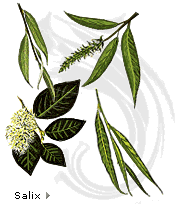Willow  The trees of this genus, that include more than 300 species, are the ones with the broader geographical area of distribution: through the whole Northern Hemisphere, penetrating to the south in South America and South Africa. The existence of numerous hybrids complicates its identification. Its appearance is very variable, from the pioneers creeping species to the tall trees, some of which produces a valuable wood, but there are many shrub species that have no principal trunk. The buds of all the willows are covered by one circular scale and, unless in rare exceptions, the female and male flowers are formed over different stems. The open female catkins are green-silver with white stigmas, while the males have golden anthers. The seeds are tiny, each one with a tuft of white bristle, and only germinate in soaked soils, that explains why willows proliferate near watercourses and in marshy areas. Generally they propagate through slips that easily grow root. In fact, the willow stem cuttings cleaved in the soil often grow roots and start to sprout. Most species have long, narrow and alternate leaves but there are exceptions. The trees of this genus, that include more than 300 species, are the ones with the broader geographical area of distribution: through the whole Northern Hemisphere, penetrating to the south in South America and South Africa. The existence of numerous hybrids complicates its identification. Its appearance is very variable, from the pioneers creeping species to the tall trees, some of which produces a valuable wood, but there are many shrub species that have no principal trunk. The buds of all the willows are covered by one circular scale and, unless in rare exceptions, the female and male flowers are formed over different stems. The open female catkins are green-silver with white stigmas, while the males have golden anthers. The seeds are tiny, each one with a tuft of white bristle, and only germinate in soaked soils, that explains why willows proliferate near watercourses and in marshy areas. Generally they propagate through slips that easily grow root. In fact, the willow stem cuttings cleaved in the soil often grow roots and start to sprout. Most species have long, narrow and alternate leaves but there are exceptions.
Encyclopedia BLUME, Trees, wood and forests of the world, H. Edlin/M.Nimmo, page 132.
|

